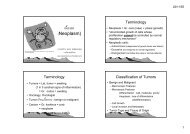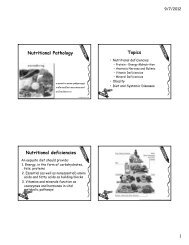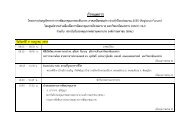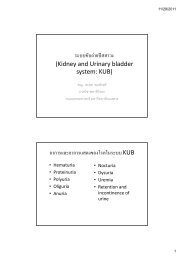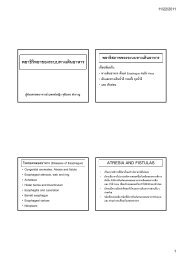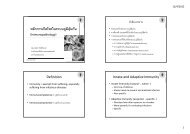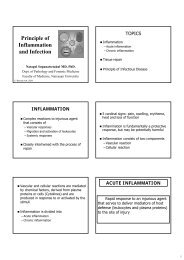เนื้องอก (Neoplasm) - มหาวิทยาลัยนเรศวร
เนื้องอก (Neoplasm) - มหาวิทยาลัยนเรศวร
เนื้องอก (Neoplasm) - มหาวิทยาลัยนเรศวร
Create successful ePaper yourself
Turn your PDF publications into a flip-book with our unique Google optimized e-Paper software.
<strong>เนื้องอก</strong><br />
(<strong>Neoplasm</strong>)<br />
นายแพทย ดร. ณตพล<br />
ศุภณัฐเศรษฐกุล<br />
ภาควิชาพยาธิวิทยาและนิติเวชศาสตร<br />
คณะแพทยศาสตร <strong>มหาวิทยาลัยนเรศวร</strong><br />
30 พฤศจิกายน พ.ศ. 2553
หัวขอบรรยาย<br />
• ความหมายของ<strong>เนื้องอก</strong> และชนิดของ<strong>เนื้องอก</strong><br />
• ความแตกตางระหวาง<strong>เนื้องอก</strong>ธรรมดา และชนิดรายแรง<br />
• ทฤษฎีการเกิดมะเร็ง<br />
– ทฤษฎีสองขั้นตอน (initiator, promoter)<br />
– ทฤษฎีหลายขั้นตอน (initiator, promoter, progressive)<br />
– malignant<br />
• สาเหตุของการเกิดมะเร็ง (สารเคมี, ไวรัส, รังสี)
• กลไกของการเกิดมะเร็ง<br />
– การแบงระยะของมะเร็ง (grading and staging of tumor)<br />
– การแพรกระจายของมะเร็ง<br />
– อาการและอาการแสดงของโรคมะเร็ง<br />
• การคนหาและปองกันโรคมะเร็ง<br />
– การตรวจรางกายประจําป<br />
– สัญญาณอันตราย<br />
– บัญญัติ 10 ประการในการปองกันมะเร็ง<br />
– การตรวจทางหองปฏิบัติการ (tumor marker)
Neoplasia<br />
• Cellular proliferation : การเพิ่มจํานวน, ขนาดของเซลล และอวัยวะ<br />
– Growth (Physiolosic proliferation) : breast, uterus, marrow<br />
– Adaptation, reversible, non-neoplastic : hyperplasia<br />
proliferative endometrium, benign prostatic hyperplasia<br />
• Neoplasia = กอน<strong>เนื้องอก</strong>ที่เกิดจากการเพิ่มจํานวนและขนาดของเซลล อันเปน<br />
ผลเนื่องจากการกระตุน และแมวาไมมีสิ่งกระตุนแลว เซลลที่ผิดปกติก็ยังเพิ่มจํานวนอยู<br />
ตลอด<br />
• <strong>Neoplasm</strong> = A new growth = tumor = mass<br />
– Malignant tumor = cancer = <strong>เนื้องอก</strong>ชนิดรายแรง, มะเร็ง<br />
–Benign tumor= <strong>เนื้องอก</strong>ชนิดไมรายแรง, <strong>เนื้องอก</strong>ธรรมดา<br />
• Oncology = The study of tumors or neoplasms
Neoplasia<br />
• Definition: “ A neoplasm is an abnormal<br />
mass of tissue, the growth of which<br />
exceeds and is uncoordinated with that of<br />
the normal tissues and persists in the<br />
same excessive manner after cessation of<br />
the stimuli which evoked the change”<br />
• Cause: “Heritable genetic alterations that<br />
are passed down to the progeny of the<br />
tumor cells” “autonomous”
Benign and Malignant tumors<br />
หลักเกณฑในการพิจารณา<br />
• Differentiation (ลักษณะของ<strong>เนื้องอก</strong>เมื่อเทียบกับเซลลปกติ)<br />
• Anaplasia (<strong>เนื้องอก</strong>ที่มีลักษณะรูปราง และการทํางานของเซลล และ<br />
เนื้อเยื่อแตกตางไปจากเซลลตนกําเนิด)<br />
• Rate of growth (อัตราการเจริญเติบโต)<br />
• Local invasion (การรุกรานเนื้อเยื่อปกติขางเคียง)<br />
• Metastasis (การแพรกระจายของ<strong>เนื้องอก</strong>ไปเจริญเติบโตในเนื้อเยื่อสวน<br />
อื่นที่อยูหางไกลออกไป)
Benign & Malignant Tumors<br />
Characteristics<br />
Histology<br />
(differentiation,<br />
anaplasia)<br />
Growth rate<br />
Localization<br />
invasion<br />
Metastasis<br />
Recurrence<br />
Prognosis<br />
Slow<br />
Local, capsule<br />
No<br />
Rare<br />
Good<br />
Benign<br />
- Typical of<br />
tissue of origin<br />
- Well diff. with<br />
no anaplasia<br />
- Poorly diff.<br />
- Anaplastic,<br />
abnormal cell<br />
size and shape<br />
Rapid<br />
Infiltrative<br />
Yes<br />
Common<br />
Poor<br />
Malignant
Terminology<br />
• Benign tumors: suffix -oma<br />
–Gland<br />
Adenoma<br />
– Squamous cell Squamous cell papilloma<br />
–Fat<br />
Lipoma<br />
• Malignant tumors: suffix -carcinoma, -sarcoma<br />
–Gland<br />
Adenocarcinoma<br />
– Squamous cell Squamous cell carcinoma<br />
–Fat<br />
Liposarcoma
Terminology<br />
• Malignant tumors with -oma:<br />
• Seminoma (germ cell tumor of testis)<br />
• Lymphoma (Malignant lymphoma)<br />
• Melanoma (Malignant melanoma)<br />
• Hepatoma (Hepatocellular carcinoma)<br />
• Mixed tumor: Fibroadenoma<br />
• Teratogenous: Teratoma (dermoid cyst)
Teratoma (dermoid cyst): hair, teeth, cartilage, sebaceous<br />
http://www.med.cmu.ac.th/student/patho/Surapan/106.jpg
Characteristics of Cancers<br />
• Autonomous<br />
– ↑ Growth-promoting<br />
– ↓ Growth-inhibiting<br />
• Immortal (Apoptosis ↓)<br />
• Angiogenesis<br />
• Loss of differentiation<br />
• Invasion/ Metastasis
Carcinogenesis<br />
• Carcinogenesis:<br />
– Initiation: genetic mutation<br />
– Promotion: growth promotion<br />
– Progression: development of malignant<br />
behaviors<br />
• Carcinogens:<br />
– Complete carcinogen: initiation & promotion<br />
– Incomplete carcinogen: promotion
Carcinogens<br />
• Chemical:<br />
– Benzo(a)pyrene (cigarette) lung cancer<br />
– Aflatoxin hepatoma (liver)<br />
– Nitrosamine cholangiocarcinoma (liver)<br />
• Radiation:<br />
– UV light skin cancer<br />
– X-ray leukemia, thyroid cancer<br />
• Virus:<br />
– EBV lymphoma
Genetic Mechanisms of CA<br />
• Altered expression of cellular genes<br />
“somatic genetic disorders”<br />
– Nonlethal genetic damage<br />
• Proto-oncogenes<br />
• Tumor supressor genes<br />
– Clonal expansion<br />
– DNA repair defect<br />
– Acquire new mutations malignant properties
Proto-oncogenes<br />
oncogenes<br />
• Oncogenes cancer cells<br />
• Proto-oncogenes normal cells<br />
• Proto-oncogenes mutation oncogenes<br />
• Oncogenes oncoproteins promote<br />
autonomous cell growth<br />
• Categories: growth factors (PDGF),<br />
receptors (EGFR), cytoplasmic signal<br />
molecules (K-RAS), nuclear transcription<br />
factors (c-myc)
Tumor Supressor Genes<br />
• Growth inhibitory signals<br />
– Rb gene: retinoblastoma, osteosarcoma<br />
– P53: most human cancers<br />
– BRCA-1/BRCA-2: breast & ovarian cancers<br />
• 3% all breast cancer<br />
• 80% familial breast cancer<br />
• Evasion of apoptosis<br />
–Bcl-2
Grading and Staging<br />
• Grading: histologic characterization of<br />
tumor cells and is basically a<br />
determination of the degree of anaplasia<br />
(grade 1, 2, 3, 4)<br />
• Staging: location and pattern of spread of<br />
a tumor within the host<br />
– International Contre Center TNM (tumor,<br />
Node, Metastasis)<br />
– American Joint Committee Stage 0 - IV
http://www.prostate-cancer.org/education/staging/img/Dowd_GleasonScoreFig1.jpg
http://edoc.hu-berlin.de/dissertationen/kaiser-simone-2004-06-10/HTML/kaiser2_html_7fe064af.png
Invasion and Metastasis<br />
• Invasion of extracellular matrix<br />
• Invasion into vascular<br />
• Vascular dissemination<br />
– Lymphatic lymph nodes<br />
– Blood vessels distant organs<br />
• Tumor implantation<br />
– Favoring location homing
Effects of cancer on body<br />
• Location & impingement on adjacent<br />
structures<br />
• Functional activity such as hormone<br />
• Bleeding & secondary infections<br />
• Initiation of acute symptoms (rupture,<br />
infarction)
Effect of cancer on body<br />
• Cachexia: overall weight loss and generalized<br />
weakness<br />
– Anorexia (loss of appetite)<br />
– High metabolism by cancer cells<br />
– Therapeutic effect nausea, vomiting<br />
• Pain: patient-controlled analgesia<br />
• Fear, depression<br />
• Paraneoplastic syndromes: venous thrombosis,<br />
cushing syndrome, hypercalcemia
Downloaded from: StudentConsult (on 28 June 2010 07:07 PM)<br />
© 2005 Elsevier
In Thailand<br />
• สถาบันมะเร็งแหงชาติ <br />
• ขอมูลจากสถาบันมะเร็งแหงชาติ ป 2008<br />
(http://www.nci.go.th/File_download/Nci%20Cancer%20Registry/2008.pdf)<br />
• มะเร็งที่พบมากที่สุดในผูชาย ไดแก<br />
Colon and rectum (17.4%), Bronchus and lung (16.2%),<br />
Liver and bile duct (10.5%),<br />
• มะเร็งที่พบมากที่สุดในผูหญิง ไดแก<br />
Breast (43%), Cervix uteri (16.4%), Colon and rectum (8.8%)
Risk factors<br />
• Tobacco use:<br />
– Lung, larynx, oral, esophagus, pancreas,<br />
cervix, bladder<br />
• Food:<br />
– Low fiber, high calories, red meat colon CA<br />
– Antioxidants (Vit. A, E, C) protective<br />
• Alcohol:<br />
– Liver, oral, esophagus
การคนหาและปองกันมะเร็ง<br />
• สถาบันมะเร็งแหงชาติ (http://www.nci.go.th/index.html)<br />
• การตรวจหามะเร็งระยะเริ่มแรก<br />
http://www.nci.go.th/Knowledge/firststep.html<br />
• ขอพึงปฏิบัติในการปองกันการเกิดโรคมะเร็ง<br />
http://www.nci.go.th/Knowledge/do12.html<br />
• ความรูทั่วไปเกี่ยวกับโรคมะเร็ง<br />
http://www.nci.go.th/Knowledge/filedownload.html#07
References<br />
• Kumar V., Abbas A. K., Fausto N., “Robbins and<br />
Cotran Pathologic Basis of Disease, 7 th edition.”,<br />
Elsevier Saunders, 2005, p. 3-46.<br />
• Kumar V., Cotran R.S., Robbins S.L., “Robbins<br />
Basic Pathology, 7 th edition.” Saunders, 2003,<br />
p.3-31.



